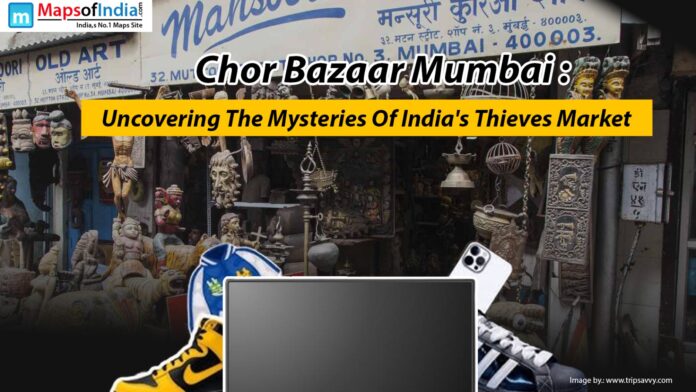Chor Bazaar Mumbai: Uncovering the Mysteries of India’s Thieves’ Market
Imagine stumbling upon a hidden world where time stands still. Antiques whisper forgotten stories, rusted gramophones hum with echoes of the past, and the warm, musty scent of old books envelopes you like a memory. Welcome to Chor Bazaar Mumbai, a marketplace that feels more like a time capsule than a shopping destination. This isn’t your typical street market—it’s a treasure trove of history, mystery, and charm tucked away in the bustling heart of the city.
Often called the “Thieves’ Market,” Chor Bazaar Mumbai has a name that sparks curiosity. According to urban legend, it earned this reputation because stolen goods would mysteriously end up here. Over the decades, that mystique stuck, though today it’s more about rare finds and vintage collectibles than anything illicit. Still, the sense of secrecy and adventure remains.
As you wander through its narrow alleys, you’ll come across everything from antique Bollywood posters and retro furniture to brass telescopes, typewriters, colonial-era coins, and vinyl records from a bygone era. Each shop tells its own story, and every object seems to carry the weight of a hundred tales. You might even find car parts from long-lost models or quirky clocks that still tick with a hint of old-world charm.
But Chor Bazaar Mumbai isn’t just about what you can buy—it’s about the experience. It’s about chatting with shopkeepers who’ve been here for generations, each with anecdotes richer than the items they sell. It’s about slowing down in a city known for its chaos and immersing yourself in nostalgia, one step at a time.
The market also holds cultural value. It’s a living museum, reflecting the layers of Mumbai’s history and the changing tastes of its people. Tourists and locals alike are drawn not just by the promise of bargains but by the character of the place. It’s gritty, authentic, and full of personality.
Whether you’re a collector, a curious traveler, or someone simply looking for a story to tell, Chor Bazaar Mumbai promises an unforgettable experience. It’s a place where the past comes alive in the most unexpected ways—where every corner invites you to pause, look closer, and maybe even take a piece of history home with you.
A Walk Through History: Tracing Chor Bazaar’s Roots
Chor Bazaar’s history runs deep, stretching back several centuries. It’s believed that the market may have originally gained its reputation by dealing in stolen goods—after all, “chor” means “thief” in Hindi. However, another popular theory suggests that the market was once called “Shor Bazaar,” meaning “noisy market,” thanks to the constant buzz of traders and shoppers. Over time, it’s said that the British, unable to pronounce “shor” correctly, mispronounced it as “chor,” and the name stuck.
Today, Chor Bazaar Mumbai has transformed into one of the largest and most fascinating flea markets in the country. From antique furniture and vintage décor to old Bollywood posters, rare books, quirky collectibles, and even second-hand electronics—you’ll find a little bit of everything here.
Walking through its crowded lanes feels like taking a step back in time. Each turn reveals a new surprise, and every shop holds pieces of history just waiting to be discovered. Whether you’re a curious wanderer or a dedicated collector, exploring Chor Bazaar is truly an unforgettable experience.
Colonial Influences and the Market’s Transformation
The British colonial era influenced Chor Bazaar greatly. Mumbai became a trading hub. This shifted the market’s focus. At first, ordinary things were available. But then, surplus and possibly stolen goods appeared. British items mixed with Indian wares. It created a unique blend. The market structure changed to reflect this. It became a place to find almost anything. The colonial past helped make Chor Bazaar what we see now.
Navigating the Labyrinth: What to Expect at Chor Bazaar
Walking into Chor Bazaar is quite an experience. It can overwhelm you. It’s a maze of narrow lanes. Vendors call out their wares. The air buzzes with energy. Knowing what to expect helps. You will discover the market’s layout and what you can find there.
Haggling 101: Mastering the Art of Negotiation
Haggling is crucial at Chor Bazaar. It’s part of the culture. Don’t accept the first price given. Start low and bargain up. Be respectful and friendly. Use phrases like “Thoda kam karo” (reduce the price a bit). Or “Kya rate hai?” (What is the price?). Remember, smiling helps. Bargaining well can lead to great deals.
Treasures and Trinkets: A Glimpse into the Goods
Chor Bazaar offers a huge range of goods. You can find antiques, vintage items, and electronics. Old movie posters and furniture are common. Spare car parts are available. You might even find old coins. Unique finds might include antique clocks, vintage cameras, and Bollywood memorabilia. The range is constantly changing.
Is it Stolen?: Separating Fact from Fiction
The question of stolen goods always seems to surface when people talk about Chor Bazaar, Mumbai. Is everything sold there really stolen? The truth is far more nuanced.
While the market may have earned its “thieves’ market” nickname in the past, possibly due to items of questionable origin finding their way here, things have changed over time. Today, Chor Bazaar is more about second-hand goods, antiques, and vintage finds than stolen merchandise. It’s a mix of old, rare, and repurposed items, often sold by vendors who’ve been in the business for generations.
So, let’s clear the air: Chor Bazaar isn’t some shady black market. It’s a vibrant, culturally rich space where history, trade, and storytelling come together in a way that’s uniquely Mumbai.
The Reality of “Second-Hand” vs “Stolen”
Most items at Chor Bazaar are second-hand. They may be unwanted things or surplus stock. Some goods could be from questionable sources. It’s vital to know the difference. Buying stolen items supports illegal activity. Be aware of the legal and ethical problems.
Due Diligence: How to Shop Responsibly
Shop responsibly at Chor Bazaar. Check the item’s history. Ask the vendor where it came from. Look for signs of damage or alteration. If a price seems too good, be wary. Research items before you go. Trust your gut feeling. Walk away if something feels wrong.
Beyond the Bargains: The Cultural Significance of Chor Bazaar
Chor Bazaar is more than just a market. It’s a cultural center. It contributes to Mumbai’s special identity. This place has a soul. Let’s explore its role in the city.
A Melting Pot of Cultures and Commerce
Chor Bazaar brings together different people. You’ll find many communities and subcultures here. It’s a place for social interaction. It reflects Mumbai’s varied character. It displays a blend of the new and the old. People from various walks of life congregate there.
Chor Bazaar in Popular Culture: Film, Literature, and Art
Chor Bazaar has appeared in films, books, and art. It’s often shown as a mysterious place. Some stories romanticize it. Some criticize it. “Don” and “Once Upon a Time in Mumbai” are examples of films using it. It adds color and drama to these stories.
Tips for Visiting Chor Bazaar
Planning to visit Chor Bazaar? Here’s some useful advice. Get ready for an adventure. Knowing these value points will make your trip easier.
When to Go and How to Get There
Visit Chor Bazaar on weekdays to avoid crowds. Sundays are very busy. Most shops open around 11 AM. They close by 7:30 PM. Use public transport. Taxis are also an option. The nearest train station is Grant Road.
Staying Safe and Aware: Protecting Yourself from Scams
Beware of common scams in Chor Bazaar. Watch out for pickpockets in the crowds. Keep your belongings safe. Don’t show large amounts of money. Be careful of overly friendly strangers. Always stay aware of your area.
Conclusion
Chor Bazaar in Mumbai remains a fascinating place. It has a rich history and varied offerings. It is a cultural landmark. The market’s appeal lies in its mystery. It shows Mumbai’s spirit. Visiting Chor Bazaar is an experience. Shop wisely, and enjoy the adventure. This place is one of a kind.




